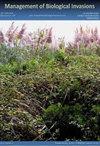哥伦比亚河流域北梭子鱼入侵机制
IF 1.5
4区 环境科学与生态学
Q3 BIODIVERSITY CONSERVATION
引用次数: 1
摘要
水生入侵物种的传播通常是通过自然传播和人为传播相结合的方式发生的。对于许多水生入侵物种来说,自然扩散仅限于连接栖息地的水生走廊。相比之下,人类的运输可能会促进更远的分散和在不相连的水体之间的运输。遗传信息可以作为追踪入侵历史和确定入侵物种扩散来源和机制的有力工具。利用遗传信息研究了哥伦比亚河流域北梭子鱼的入侵历史和入侵动态。结果表明,北梭子鱼最初进入Pend Oreille河(华盛顿州东部)是由于人类运输鱼类,而不是来自上游已建立种群的分散。随后的繁殖和从Pend Oreille河的自然分散导致北派克下游扩展到罗斯福湖,这是哥伦比亚河主干线内的一个水库。这些结果强调需要一个整体的方法来抑制入侵物种。必须立即努力解决自然扩散的生物机制。持续的镇压和根除必须采取广泛的办法,包括管理机构之间的协调,以及旨在防止重复的人类运输事件的政策和公共宣传。从这项研究中创建的基因数据库已经被用于消除哥伦比亚河流域以外华盛顿州新入侵的北梭子鱼的潜在来源种群。这突出了遗传监测对管理水生物种入侵的即时和长期应用的效用。本文章由计算机程序翻译,如有差异,请以英文原文为准。
Mechanism of northern pike invasion in the Columbia River Basin
The spread of aquatic invasive species typically occurs through a combination of natural and human mediated dispersal. For many aquatic invasive species, natural dispersal is limited to aquatic corridors connecting habitat. In contrast, human transport may facilitate more distant dispersal and transport among disconnected waterbodies. Genetic information can serve as a powerful tool to track invasion histories and identify both the sources and mechanisms of invasive species dispersal. We used genetic information to understand invasion history and dynamics of expanding northern pike invasion in the Columbia River basin. Results indicate that the initial introduction of northern pike into the Pend Oreille River (in eastern Washington State) resulted from human transport of fish, not dispersal from established populations upstream. Subsequent reproduction and natural dispersal from the Pend Oreille River resulted in downstream expansion of northern pike into Lake Roosevelt, a reservoir within the mainstem Columbia River. These results highlight the need for a holistic approach to suppression of invasive species. Immediate efforts must address the biological mechanisms of natural dispersal. Sustained suppression and eradication must take a broad approach that includes coordination between management agencies, as well as policy and public outreach aimed at prevention of repeated human transport events. The genetic database created from this study has already been used to eliminate potential source populations for new northern pike invasions in Washington State outside the Columbia River basin. This highlights the utility of genetic monitoring for both immediate and long-term applications to managing aquatic species invasions.
求助全文
通过发布文献求助,成功后即可免费获取论文全文。
去求助
来源期刊

Management of Biological Invasions
Agricultural and Biological Sciences-Ecology, Evolution, Behavior and Systematics
CiteScore
3.40
自引率
6.70%
发文量
21
审稿时长
16 weeks
期刊介绍:
Management of Biological Invasions, established in 2010 by Dr. Elias Dana, is an open access, peer-reviewed international journal focusing on applied research in biological invasions in aquatic and terrestrial ecosystems from around the world. This journal is devoted to bridging the gap between scientific research and the use of science in decision-making, regulation and management in the area of invasive species introduction and biodiversity conservation.
Managing biological invasions is a crisis science, with Management of Biological Invasions aiming to provide insights to the issues, to document new forms of detection, measurements and analysis, and to document tangible solutions to this problem.
In addition to original research on applied issues, Management of Biological Invasions publishes technical reports on new management technologies of invasive species and also the proceedings of relevant international meetings. As a platform to encourage informed discussion on matters of national and international importance, we publish viewpoint papers that highlight emerging issues, showcase initiatives, and present opinions of leading researchers.
 求助内容:
求助内容: 应助结果提醒方式:
应助结果提醒方式:


